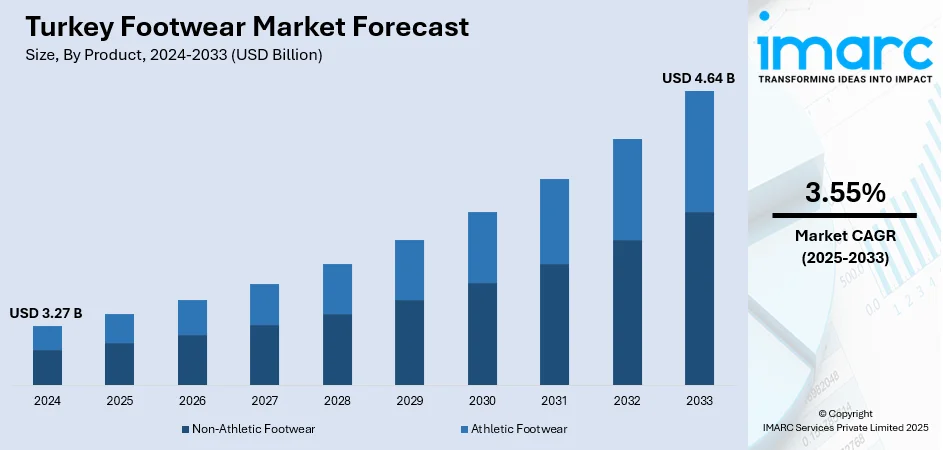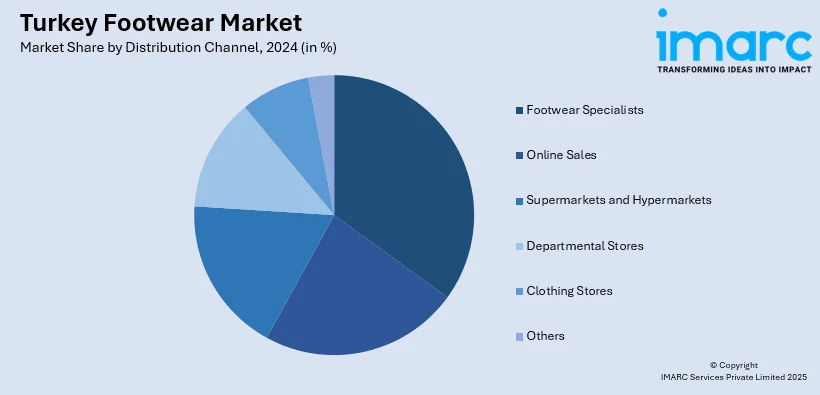
Turkey Footwear Market Size, Share, Trends and Forecast by Product, Material, Distribution Channel, Pricing, End User, and Region, 2025-2033
Turkey Footwear Market Overview:
The Turkey footwear market size reached USD 3.27 Billion in 2024. Looking forward, the market is expected to reach USD 4.64 Billion by 2033, exhibiting a growth rate (CAGR) of 3.55% during 2025-2033. The market is expanding due to changing fashion trends, growing urbanization, and rising consumer preference for branded and comfortable footwear. Increased online retail penetration and demand for sports and casual shoes further support market growth. These evolving dynamics are shaping brand competition and consumer behavior, contributing to shifts in the Turkey footwear market share.
|
Report Attribute
|
Key Statistics
|
|---|---|
|
Base Year
|
2024
|
|
Forecast Years
|
2025-2033
|
|
Historical Years
|
2019-2024
|
| Market Size in 2024 | USD 3.27 Billion |
| Market Forecast in 2033 | USD 4.64 Billion |
| Market Growth Rate 2025-2033 | 3.55% |
Turkey Footwear Market Trends:
Urbanization and Rising Disposable Income
Rapid urbanization in Turkey is fostering higher disposable incomes among a growing urban middle class. As city dwellers seek fashionable yet functional footwear, demand for a diverse range of shoes, sports, casual, formal, has surged. The urban lifestyle also encourages frequent footwear purchases to match varied daily activities and social occasions. Turkish consumers, increasingly influenced by both domestic brands and international trends, display a willingness to spend on quality and design. Government incentives to stimulate manufacturing and exports enhance these dynamics, enabling brands to offer quality footwear at competitive prices. With higher living standards, consumers are investing more in footwear, driving steady expansion in Turkey’s footwear sector.

To get more information on this market, Request Sample
E-Commerce Expansion & Digital Retail Integration
The Turkey footwear market growth is also driven by the swift expansion of e-commerce platforms. Leading online marketplaces are capturing consumer interest through convenience, broader selections, and frequent promotions. Younger, tech-savvy shoppers prefer online browsing and buying, especially for sneakers, athleisure, and casual footwear. The COVID-19 pandemic further accelerated online sales growth, prompting brands and retailers to develop user-friendly digital storefronts, virtual fitting tools, and seamless return policies. Integration with mobile apps, social media campaigns, and influencers enhances brand visibility and consumer engagement. Consequently, digital retail has become a central growth driver, enabling efficient inventory management and deeper consumer data insights that sustain the market’s competitiveness.
Innovation and Focus on Sustainability
Innovation in materials, like recycled rubber, organic leather, and bio-based synthetics, is gaining traction among environmentally conscious Turkish consumers. Footwear brands are investing in sustainable manufacturing processes, driven by stringent environmental regulations and rising global eco awareness. Turkish manufacturers are integrating new design technologies, such as automated cutting and digital production, to enhance efficiency and product quality. Exporters target European markets by emphasizing ethical sourcing and eco-friendly credentials. Domestic adoption of sustainable fashion is also spreading, with consumers demanding transparency and traceability. This shift toward greener, high-quality footwear strengthens Turkey’s competitive edge and expands its appeal both domestically and internationally.
Turkey Footwear Market Segmentation:
IMARC Group provides an analysis of the key trends in each segment of the market, along with forecasts at the country and regional levels for 2025-2033. Our report has categorized the market based on product, material, distribution channel, pricing, and end user.
Product Insights:
- Non-Athletic Footwear
- Athletic Footwear
The report has provided a detailed breakup and analysis of the market based on the product. This includes non-athletic footwear and athletic footwear.
Material Insights:
- Rubber
- Leather
- Plastic
- Fabric
- Others
A detailed breakup and analysis of the market based on the material have also been provided in the report. This includes rubber, leather, plastic, fabric, and others.
Distribution Channel Insights:

- Footwear Specialists
- Online Sales
- Supermarkets and Hypermarkets
- Departmental Stores
- Clothing Stores
- Others
The report has provided a detailed breakup and analysis of the market based on the distribution channel. This includes footwear specialists, online sales, supermarkets and hypermarkets, departmental stores, clothing stores, and others.
Pricing Insights:
- Premium
- Mass
A detailed breakup and analysis of the market based on pricing have also been provided in the report. This includes premium and mass.
End User Insights:
- Men
- Women
- Kids
The report has provided a detailed breakup and analysis of the market based on the end user. This includes men, women, and kids.
Regional Insights:
- Marmara
- Central Anatolia
- Mediterranean
- Aegean
- Southeastern Anatolia
- Blacksea
- Eastern Anatolia
The report has also provided a comprehensive analysis of all the major regional markets, which include Marmara, Central Anatolia, Mediterranean, Aegean, Southeastern Anatolia, Blacksea, and Eastern Anatolia.
Competitive Landscape:
The market research report has also provided a comprehensive analysis of the competitive landscape. Competitive analysis such as market structure, key player positioning, top winning strategies, competitive dashboard, and company evaluation quadrant has been covered in the report. Also, detailed profiles of all major companies have been provided.
Turkey Footwear Market Report Coverage:
| Report Features | Details |
|---|---|
| Base Year of the Analysis | 2024 |
| Historical Period | 2019-2024 |
| Forecast Period | 2025-2033 |
| Units | Billion USD |
| Scope of the Report |
Exploration of Historical Trends and Market Outlook, Industry Catalysts and Challenges, Segment-Wise Historical and Future Market Assessment:
|
| Products Covered | Non-Athletic Footwear, Athletic Footwear |
| Materials Covered | Rubber, Leather, Plastic, Fabric, Others |
| Distribution Channels Covered | Footwear Specialists, Online Sales, Supermarkets and Hypermarkets, Departmental Stores, Clothing Stores, Others |
| Pricings Covered | Premium, Mass |
| End Users Covered | Men, Women, Kids |
| Regions Covered | Marmara, Central Anatolia, Mediterranean, Aegean, Southeastern Anatolia, Blacksea, Eastern Anatolia |
| Customization Scope | 10% Free Customization |
| Post-Sale Analyst Support | 10-12 Weeks |
| Delivery Format | PDF and Excel through Email (We can also provide the editable version of the report in PPT/Word format on special request) |
Key Questions Answered in This Report:
- How has the Turkey footwear market performed so far and how will it perform in the coming years?
- What is the breakup of the Turkey footwear market on the basis of product?
- What is the breakup of the Turkey footwear market on the basis of material?
- What is the breakup of the Turkey footwear market on the basis of distribution channel?
- What is the breakup of the Turkey footwear market on the basis of pricing?
- What is the breakup of the Turkey footwear market on the basis of end user?
- What is the breakup of the Turkey footwear market on the basis of region?
- What are the various stages in the value chain of the Turkey footwear market?
- What are the key driving factors and challenges in the Turkey footwear market?
- What is the structure of the Turkey footwear market and who are the key players?
- What is the degree of competition in the Turkey footwear market?
Key Benefits for Stakeholders:
- IMARC’s industry report offers a comprehensive quantitative analysis of various market segments, historical and current market trends, market forecasts, and dynamics of the Turkey footwear market from 2019-2033.
- The research report provides the latest information on the market drivers, challenges, and opportunities in the Turkey footwear market.
- Porter's five forces analysis assist stakeholders in assessing the impact of new entrants, competitive rivalry, supplier power, buyer power, and the threat of substitution. It helps stakeholders to analyze the level of competition within the Turkey footwear industry and its attractiveness.
- Competitive landscape allows stakeholders to understand their competitive environment and provides an insight into the current positions of key players in the market.
Need more help?
- Speak to our experienced analysts for insights on the current market scenarios.
- Include additional segments and countries to customize the report as per your requirement.
- Gain an unparalleled competitive advantage in your domain by understanding how to utilize the report and positively impacting your operations and revenue.
- For further assistance, please connect with our analysts.
 Request Customization
Request Customization
 Speak to an Analyst
Speak to an Analyst
 Request Brochure
Request Brochure
 Inquire Before Buying
Inquire Before Buying




.webp)




.webp)












